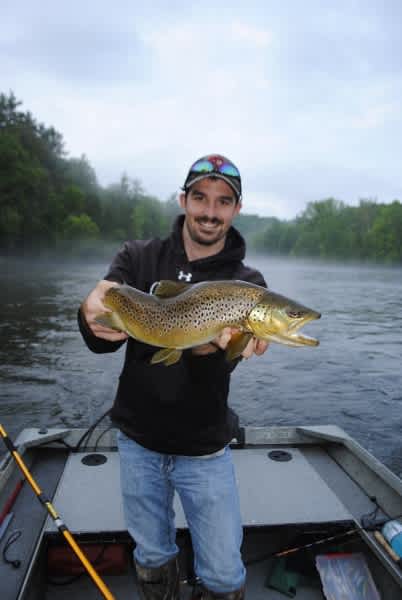Throwing Big Baits for Big Michigan Trout
Bob Gwizdz 06.22.15

For once, the weatherman was right. He’d promised mostly overcast and some rain, and by 8:30 a.m., it started falling. Which is just what we wanted.
Most guys don’t especially want to fish in the rain. But that’s the prescription for what we were doing—throwing big jerk baits for trout.
I was with Denny Bouwens and his buddy Drew Blackall on the Muskegon River just downstream from Croton Dam (the first dam upstream from Lake Michigan), where some big brown trout are known to live.
“It’s matter of choosing the right day,” said Bouwens, who is a long-time fishing guide for just about anything that swims. “Overcast, rainy, drizzly days.
“You have a small window—May and June. You want the water temperature in the 50s or 60s. When it gets warmer, those fish are not willing to chase.”
They were chasing all right, but biting a little less so. Right away we moved a big brown that charged out and eyeballed my Shadow Rap, but declined to commit. But after three or four follows, Blackall latched onto a good one.
He played it carefully—it was an honest two-footer—and when he brought it to net, he and Bouwens were high-fiving.
It was a giant trout with a hump on its back like a mature male pink salmon. It looked like a cross between a sea serpent and a sway-backed horse. We snapped a few photos and returned in to the lake. A few minutes later, I latched onto a nice fish (about 18 inches by my eyeball tape measure) that fell to a gold and black countdown Rapala.
In between, we’d moved a few more that changed their minds at the moment of truth.
”This is kind of like muskie fishing,” Bouwens said. “You see a lot of fish chase. You see a lot of fish follow.”
You know how streamer fishermen talk about how many fish they “moved” or “turned’ instead of how many they caught? It was like that: We were getting a lot of attention, but far fewer bites. That’s the way this fishing is.
Blackall hit another fish: a 20-plus inch rainbow. It looked like a spawned out hen steelhead to all of us.
We floated downstream throwing all manner of minnow-style baits. Blackall was getting a lot of attention on a Daiwa bait, while I stayed mostly with Rapalas and a Pointer.
“If I had to go to one lure it would be an old-school Rapala,” Bouwens said. “And I’m a big fan of black and gold. I’m a big fan of the X-Rap as well. And I like Smithwicks (Rogue), too. The thing about Rapala is they’ve got a real good variety of baits—originals, Husky Jerks, Scatter Raps. I like the whole line.
“I got stuck on Rapalas because they’ll catch every fish that swims. Fish spawn and you’ll catch trout. But fish a Rapala and you’ll catch trout, smallmouths walleyes…everything.
“It’s an exciting way to fish,” he continued. “It’s hard to fish them wrong—as long as you fish them fast. You can’t fish it faster than a trout can swim.”
That’s always how I fish these baits for trout: aggressively. Keep it moving and keep it moving fast. Trout are known to be especially fussy (ever notice how subtle differences in a fly will get trout to take a fly they’ve otherwise ignored?) and my theory is you want them to notice it but not get too good a look. That’s’ one reason why I think slightly off-colored water is preferable to the gin-clear stuff we were fishing. They can see it too well.

Blackall whacked a 14-incher, then one that would go about 22 inches. He was on them. Bouwens suggested he was out-fishing me because he was in the back of the boat, getting the first shot at them—we were drifting downstream backwards—but I’m not convinced he wasn’t doing something a little differently than I was. Or the bluegill-colored lure he used was just more appealing.
I smacked a stocker rainbow, about nine inches, not very much longer than my plug. Blackall followed up with stocker brown. Guys who fish smaller baits to take advantage of the smaller trout, may catch more fish, but I’ve found over the years the big guys want big baits. It’s about conservation of energy, but that’s when trout are out in the feeding lanes, rising to them. They don’t have to chase them down.
“I like big baits for big trout,” Bouwens said. “Size 7 to 11. Or even bigger Husky Jerks.”
So we’re on the same page.
We fished until 11 a.m., by which time the bite had slowed and even our follows were fewer. It was outstanding.
“The first two hours of the morning are best, but if you choose the right day it can be all morning long,” Bouwens said. “Evenings can be good, too, but nothing beats morning light.”
You can reach Bouwens at 616-724-0303.
For more information on Michigan fishing go to michigan.org. Click here to purchase a Michigan fishing license online.
This article was produced in partnership with Pure Michigan.

